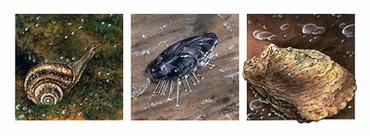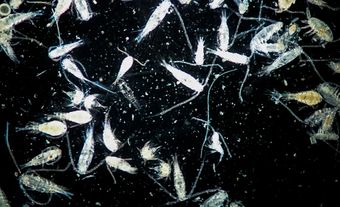
Shell is a hard covering made primarily of calcium carbonate, secreted by invertebrate animals (eg, molluscs, barnacles, sea urchins). Some shells grow with the animal; others are shed and replaced periodically. The shell provides protection, a site for muscle insertion and, in a few cases, buoyancy. In most molluscs it consists of 3 layers secreted by the mantle and its marginal lobes. The outer layer (periostracum) consists of an organic material, conchiolin. It may be thin and glossy or coarse, flaky or spiny.
The underlying prismatic layer, usually the thickest part of the shell, consists of calcium carbonate crystals laid down in an organic matrix, obliquely or at right angles to the periostracum. The inner layer is of similar composition but is laid down as flat plates. This often iridescent, nacreous layer is called mother of pearl because if a sand grain or a parasite becomes trapped between mantle and shell, nacreous material secreted around it forms a pearl. Many bivalves, including common freshwater mussels (Lampsilis and Anodonta) and bay mussel (Mytilus), can make pearls; the valuable forms are secreted by members of tropical genera of pearl oysters (Pinctada and Pteria). The 3 forms of crystalline calcium carbonate forming the shell are calcite, aragonite and vaterite. Calcium is less abundant in fresh water than in the ocean; consequently, pond snails have thin, fragile shells, which can be partly regenerated following injury.
The study of shells, conchology, dates to the 17th century when merchants and explorers brought back tropical shells for the "curiosity cabinets" of the wealthy. Until Linnaeus's system of taxonomy was accepted in the late 18th century, conchology was relatively unscientific. It flourished during the Victorian era when popular interest in natural history was fueled by such voyages of discovery as the Challenger Expedition (1872-76). This great oceanographic enterprise, which visited Halifax briefly, pioneered deep-sea dredging for marine organisms, including molluscs. Modern conchologists place as much emphasis on the biology and ecology of the organism as on the structure of its shell.
Beach specimens may be collected as souvenirs. Although sometimes worn or damaged, they indicate which species may be found alive in the vicinity. If a collection is intended to have scientific or commercial value, the animals should be collected live at low tide or by diving and dredging. The collector must make sure in advance that harvesting is permitted (some countries have strict conservation programs and ban export of rare species).
Joining a malacological or shell club, through which shells are exchanged or bought, allows collectors to acquire exotic species such as beautifully shaped and coloured cones, cowries, tuns, conches, strombids and olives. Satisfactory examples of these are often found in souvenir shops at museums and aquaria, or through dealers and catalogues. Shells may be conical, planispiral, spiral cones, dome shaped, plain or sculptured.
Shells have been collected since prehistoric times for use in adornment and mosaics, as fertility symbols, money, dishes, trumpets, sources of mortar, and adzes for constructing dugout canoes. Crusaders and pilgrims wore scallops or "coquilles St Jacques." Fossil shells are used as a means of determining the age of sedimentary rocks. The shells most likely to be found on beaches belong to one of the 5 classes of the phylum Mollusca described below.
Gastropoda
Gastropoda, including snails, whelks, limpets, cone shells, cowries and conches, are the most numerous class. Some species bear a horny or shelly covering on the foot (operculum), which can seal the opening for protection against predators or desiccation.
Amphineura
Amphineura, the chitons, have cradle or coat-of-mail shells, divided into 8 overlapping butterfly-shaped plates.
Bivalvia
Bivalvia, the clams, cockles, oysters and mussels, have 2 convex valves joined dorsally by an elastic hinge ligament. Hinge teeth help lock the valves along the hinge line. Concentric lines in the shell sculpture may be "growth checks," so-called since they result from variations in growth rate. Sculpturing may consist of spines, plates, knobs or corrugations.
Scaphopoda
Scaphopoda, the tusk or tooth shells, have a conical, tubular shell open at both ends. They were used as currency by the Northwest Coast Indians.
Cephalopoda
In octopus, cuttlefish and squid, the shell is lost or much reduced, except in Nautilus, Spirula and Argonauta (paper nautilus). Nautilus is an Indo-Pacific genus; its large, white, coiled shell, decorated with russet stripes, is common in collections. Spirula has a white, coiled shell that is washed up on Atlantic beaches as far north as Cape Cod; its shell, like that of Nautilus, is known as a chambered cone. The female Argonauta secretes a delicate, frilled pseudo-shell to protect her eggs.

 Share on Facebook
Share on Facebook Share on X
Share on X Share by Email
Share by Email Share on Google Classroom
Share on Google Classroom



